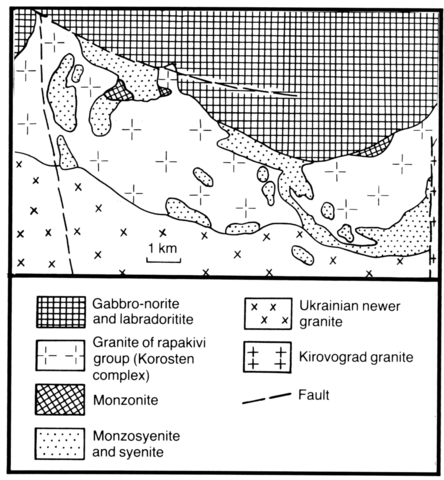stripes
In the southeast of the Korsun-Novomirgorod pluton rocks of the monzonite-syenite series, mostly quartz-bearing syenites, which are unusual in such plutons, have been identified (Krivdik et al., 1988). They show extreme iron enrichment of mafic minerals (fayalite, hedenbergite, ferrohastingsite) and a higher, compared with gabbroids and rapakivi granites, content of Zr (0.1-0.2%), light rare earths (up to 0.2%) and Nb (up to 0.02%). Accessory minerals typical of syenites include zircon, ilmenite, orthite, chevkinite and apatite. These syenites are considered to be co-magmatic rocks of the anorthosite-rapakivi granite pluton. Fayalite-hedenbergite syenites and monzosyenites occur as narrow bodies in the rapakivi granites or in the contact zone with enclosing granitoids. The largest massif, having dimensions of 4.5x2 km, is located in the southeast of the region. Drilling has detected intrusive contacts between monzonite-syenites and enclosing (new Ukrainian) granites. The relationships with the rapakivi granites of the pluton are uncertain. Predominantly medium-grained syenites become more fine-grained in the contact zone with enclosing granites. Veins of monzosyenite are fine-grained.
KRIVDIK, S.G., ORSA, V.I. and BRYANSKY, V.P. 1988. Fayalite-hedenbergite syenites of the southwestern part of the Korsun-Novomirgorod pluton. Geologicheskii Zhurnal, 6: 43-53.
SEMENENKO, N.P. SAVCHENKO, N.A. and BRITCHENKO, A.D. 1977. Cycles of volcanism of the Dneiper-Donetz basin and Donbass and metal-bearing problems of the northern slope of the Ukrainian Shield. In: Volcanism and ore-formations of the Dneprovo-Donetz basin and Donbass. AN Ukraine SSR, 156 pp.

